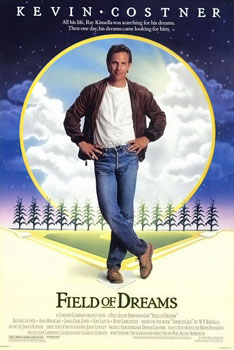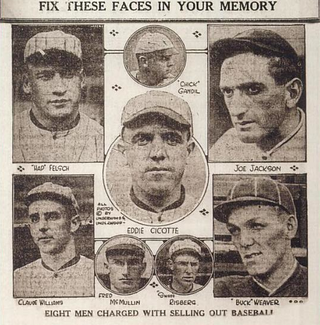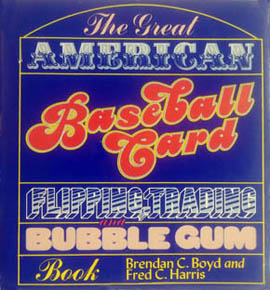
Field of Dreams is a 1989 American sports fantasy drama film written and directed by Phil Alden Robinson, based on Canadian novelist W. P. Kinsella's 1982 novel Shoeless Joe. The film stars Kevin Costner as a farmer who builds a baseball field in his cornfield that attracts the ghosts of baseball legends, including Shoeless Joe Jackson and the Chicago Black Sox. Amy Madigan, James Earl Jones and Burt Lancaster also star.

Joseph Jefferson Jackson, nicknamed "Shoeless Joe", was an American outfielder who played Major League Baseball (MLB) in the early 1900s. Although his .356 career batting average is the fourth highest in the history of Major League Baseball (MLB), he is often remembered for his association with the Black Sox Scandal, in which members of the 1919 Chicago White Sox participated in a conspiracy to fix the World Series. As a result, Commissioner Kenesaw Mountain Landis banned Jackson from baseball after the 1920 season. During the World Series in question, Jackson had led both teams in several statistical categories and set a World Series record with 12 base hits. Jackson's role in the scandal, banishment from the game, and exclusion from the Baseball Hall of Fame have been fiercely debated.

Johannes Peter "Honus" Wagner, sometimes referred to as Hans Wagner, was an American baseball shortstop who played 21 seasons in Major League Baseball from 1897 to 1917, almost entirely for the Pittsburgh Pirates. Wagner won his eighth batting title in 1911, a National League record that remains unbroken to this day, and matched only once, in 1997, by Tony Gwynn. He also led the league in slugging six times and stolen bases five times. Wagner was nicknamed "the Flying Dutchman" due to his superb speed and German heritage. This nickname was a nod to the popular folk-tale made into a famous opera by the German composer Richard Wagner. In 1936, the Baseball Hall of Fame inducted Wagner as one of the first five members. He received the second-highest vote total, behind Ty Cobb's 222 and tied with Babe Ruth at 215.

A baseball card is a type of trading card relating to baseball, usually printed on cardboard, silk, or plastic. In the 1950s, they came with a stick of gum and a limited number of cards. These cards feature one or more baseball players, teams, stadiums, or celebrities.

The Black Sox Scandal was a Major League Baseball game-fixing scandal in which eight members of the Chicago White Sox were accused of losing the 1919 World Series against the Cincinnati Reds on purpose in exchange for money from a gambling syndicate led by organized crime figure Arnold Rothstein. In response, the National Baseball Commission was dissolved and Judge Kenesaw Mountain Landis was appointed to be the first Commissioner of Baseball, given absolute control over the sport to restore its integrity.

Baseball is a 1994 American television documentary miniseries created by documentary filmmaker Ken Burns about the history of the sport of baseball.
The Goudey Gum Company was an American chewing gum company started in 1919. The company was founded by Enos Gordon Goudey (1863–1946) of Barrington Passage, Nova Scotia. Formerly an employee of Beemans, he opened a factory in Boston, Massachusetts in 1919 and later in Allston. It operated there from 1924 until it closed in 1962. Goudey sold the business in 1932 but he retained an interest as a consultant. On his retirement in 1933, William Wrigley Jr. dubbed him the "penny gum king of America". Today the Goudey name is mainly associated with its collectible baseball cards which were introduced in 1933. Goudey was the first American company to issue baseball cards with each stick of gum.

T206 is a tobacco card set issued from 1909 to 1911 in cigarette and loose tobacco packs through 16 different brands owned by the American Tobacco Company. It is a landmark set in the history of baseball card collecting, due to its size and rarity, and the quality of its color lithographs. The first series of cards were issued beginning in 1909. From 1909 to 1911 cards of over 500 major minor-league players in 16 different cigarette brands. The set featured Honus Wagner, Eddie Plank and the error cards of Larry Doyle and Sherry Magee. Several of the cards are among the most expensive sports cards ever sold.

Shoeless Joe is a 1982 magic realist novel by Canadian author W. P. Kinsella that was later adapted into the 1989 film Field of Dreams, which was nominated for three Academy Awards.

The T202 Baseball cards, also known as the Hassan Triple Folder were baseball cards manufactured and distributed by the American Tobacco Company in 1912. The cards were inserted into packs of "Hassan Cork Tip Cigarettes". Several characteristics make this vintage card a standout amongst other forms of tobacco advertising of the time and lend to its value as a highly sought-after collectible.

Honus & Me is a children's novel by Dan Gutman, published in 1997, and the first in the Baseball Card Adventures series. It was rejected by many publishers before HarperCollins finally accepted. It became a bestseller and was adapted into the 2004 made-for-television movie The Winning Season, starring Matthew Modine.

Albert Wagner, was an American professional baseball player. He played one year of Major League Baseball for two different teams during the 1898 season. He was Honus Wagner's older brother.

A rookie card is a trading card that is the first to feature an athlete after that athlete has participated in the highest level of competition within their sport. Collectors may value these first appearances more than subsequent card issues. Athletes are often commemorated on trading cards which are highly collected based on the popularity of the athlete. Prices for rookie cards fluctuate based on consumer interest, supply and demand and other factors, but can surpass thousands of dollars.

Dan Gutman is an American writer, primarily of children's fiction.

The T206 Honus Wagner baseball card depicts the Pittsburgh Pirates' Honus Wagner, known as "The Flying Dutchman,” a dead-ball era baseball player who is widely considered to be one of the best players of all time. The card was designed and issued by the American Tobacco Company (ATC) from 1909 to 1911 as part of its T206 series. Wagner refused to allow production of his baseball card to continue, either because he did not want children to buy cigarette packs to get his card, or because he wanted more compensation from the ATC. The ATC ended production of the Wagner card, and a total of only 50 to 200 cards were ever distributed to the public, as compared to the "tens or hundreds of thousands" of T206 cards, over three years in sixteen brands of cigarettes, for any other player. In 1933, the card was first listed at a price value of US$50 in Jefferson Burdick's The American Card Catalog, making it the most expensive baseball card in the world at the time.

The Great American Baseball Card Flipping, Trading and Bubble Gum Book is a book written by Brendan C. Boyd and Fred C. Harris about baseball cards, primarily ones issued during the authors' youth in 1950s, and the players on the cards.
Steve Charles (Lefty) Kraly was a Major League Baseball pitcher who played five games for the New York Yankees in 1953, compiling a 0–2 record, with a 3.24 ERA over 25 innings. He batted and threw left-handed.
The Winning Season is a 2004 television film with elements of a fantasy drama. It chronicles a young boy's dream in 1985 with playing with the Pittsburgh Pirates' great Honus Wagner. It is adapted from the 1997 children's novel Honus & Me by Dan Gutman. The film premiered on TNT on April 4, 2004.
Alan "Mr. Mint" Rosen was an American sports collectibles dealer who was especially active in the 1980s and 1990s. He advertised heavily and was a fixture at card conventions. Eventually organizers would give him a table or booth in a prime location for free because they knew he would boost attendance. In a July 4, 1988, Sports Illustrated article, Dan Geringer called him the "King of Cards" in the "high-stakes baseball card game". In 1986, he was offered and purchased the "1952 Topps Find" of baseball cards, considered one of the greatest finds ever in the hobby. He also sold nine T206 Honus Wagner baseball cards over the course of his career.
















